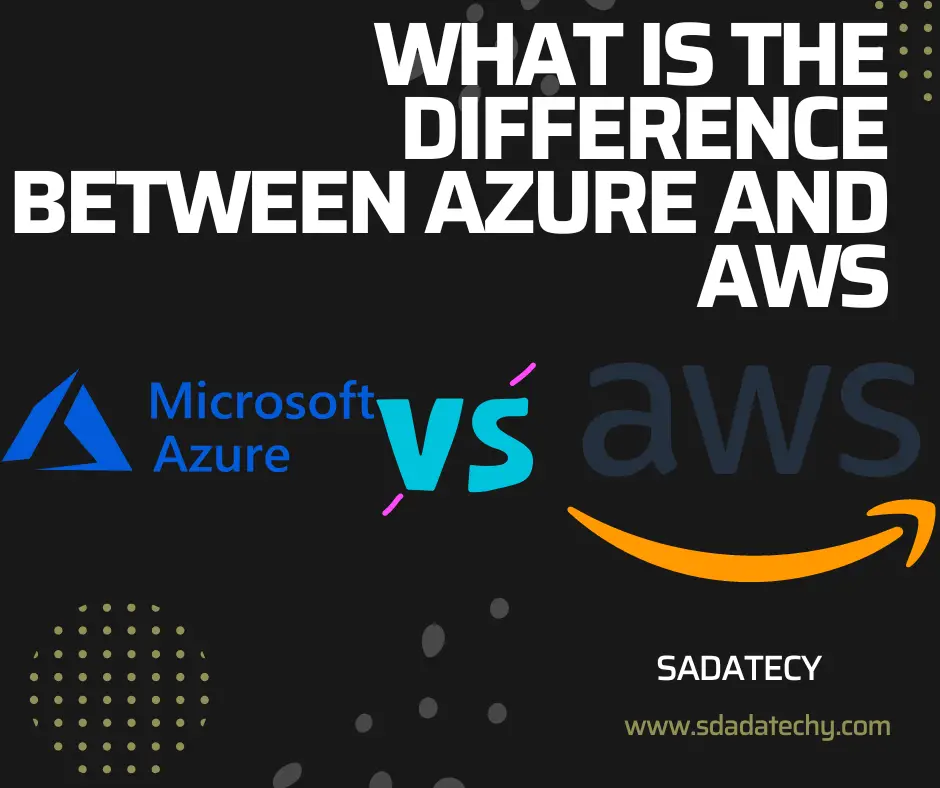What is the difference between Azure and Amazon Web Services?
What are the features of Azure and AWS, two cloud services that were born in the cloud? I will discuss the industries and services in which Azure and AWS are deployed.
The cloud service is a handy environment that may be accessed without downloading with an account. IaaS, PaaS, and SaaS are the setups for cloud-based services.
Azure is IaaS and PaaS, AWS is IaaS, PaaS and SaaS.
Microsoft Azure:
Microsoft launched Azure as a cloud service in January 2010.
It will consist of AzureVirtual and AzureMigrate for IaaS, Azure App Service for PaaS, and Office365 for SaaS, which is not included in Azure.
Extend the freedom to create, manage, and deploy apps from anywhere beyond its current constraints.
Aspects of AWS
Amazon.com introduced AWS (Amazon Web Services) in July 2006.
We supply over 175 rich services from data centers around the world that are used in every industry area, and we have amassed the requisite expertise that serves as the operating basis for the software.
Amazon Elastic Transcoder, Amazon Connect, AWS IoT Greengrass, etc. are the primary SaaS offerings.
The market share of cloud services
According to a report on the cloud service industry published by the global IT and high-tech research firm Canalys in the first quarter of 2020, the entire market rose by 34% as a result of the expansion of remote work caused by COVID-19.
In terms of market share for cloud services per firm, Amazon Web Services (AWS) is in the lead with a 32% share and is still the industry leader.
Azure maintains its No. 2 position with a 17% market share, the same as last year.
Each score
When remote work expanded in the first quarter of 2020, demand for cloud services climbed dramatically.
Let’s examine the assessment based on the outcomes of the year-over-year sales rate.
According to reports, AWS’s revenues grew over the same period last year, topping Azure in second position and Google and other cloud service providers in third.
Even though the release of Azure was delayed by many years in comparison to AWS, it has been stated that the sales growth trend has been maintained, the growth rate has grown substantially, and the sales rate has increased in comparison to the same period last year.
3 advantages of adopting Azure
I will discuss the areas in which the Microsoft Azure cloud service excels, as well as the interoperability of systems.
IaaS Azure Virtual and Machines (Azure VM) and PaaS Azure App Service classify Azure’s services.
Advantage 1 of utilizing Azure:
We specialize in certain industries Azure shines in the healthcare, financial services, public sector, distribution, and manufacturing industries.
This is because it contains features that make it a trustworthy cloud service, as well as comprehensive security support and compliance with the international standard ISO and the European General Data Protection Regulation GDPR.
The second advantage of adopting Azure is its simple compatibility with other services.
Microsoft’s SaaS capability Azure’s access management service Azure AD enables Office365 to execute single sign-on with ease.
By constructing analytical environments such as Azure Blob, SQL Data warehouse, and Azure SQL Database, and by utilizing Azure integrated services such as API Management, Logic Apps, Service Bus, and Event Grid, it is possible to link many separate systems.
Good compatibility with on-premises is the third advantage of utilizing Azure.
Because it is run in-house, on-premises offers the benefit of being customizable, but its shortcoming is the expense of maintenance and administration, such as growth and change. Azure provides several services that compensate for its limitations.
Using capabilities such as Azure Site Recovery, AzCopy, Azure Storage REST API/SDK, Azure Data Box for online transfer, and Azure Data Factory, you may move and migrate huge datasets to Azure.
3 advantages of adopting AWS
We have outlined the advantages of utilizing AWS, which has a history of offering cloud services.
I will discuss if it is feasible to handle faults and maintain stability, as well as whether a service can alter the scalability of system architecture.
One advantage of AWS is the ability to build with failure tolerance in mind.
AWS specializes in security standard services, data encryption technologies, and certification for compliance in preparation for natural catastrophes, business continuity planning, and pandemic response.
A daily monitoring system is in place to detect system configuration issues using the mathematical logic of cloud security evaluation and to preserve the system’s integrity, airtightness, and availability. The system is operational.
The second advantage of utilizing AWS is that we have a history of steady operation.
AWS’s cloud services have a track record of being picked by over a million enterprises across the world, each of which has increased operational efficiency, created new sales channels and diversified its risk exposure.
We provide sophisticated technical innovation, a secure environment, highly tailored and accurate features, as well as an environment with a follow-up system, so that businesses may utilize it at a cheap cost and with stability.
AWS, which has a lengthy history, is the major provider of cloud services.
Can manage a variety of scales is the third advantage of AWS.
AWS provides a service that anticipates demand with flexibility, allowing you to utilize the appropriate capacity at the required time.
AWS’s Amazon EC2 includes a tool that automatically optimizes size adjustment in the cloud, allowing you to construct a low-cost server.
We do not choose businesses based on their size, including start-ups, colleges, logistics corporations, and airlines.
AWS also offers a service called AWS Pricing Calculator that facilitates cost estimation.
Are there businesses that utilize cloud services jointly?
The use of cloud services may be broadly classified as hybrid cloud or multi-cloud.
A hybrid cloud is a service that combines the advantages of private, on-premises, and public clouds.
Multi-cloud refers to the usage of numerous cloud servers, such as Azure and Amazon Web Services.
IBM performed a survey of 113 firms from across the world and discovered that 94% of the companies use multiple cloud environments.
Combining the benefits and drawbacks of using cloud services
Why are a growing number of businesses utilizing both cloud services as opposed to a single cloud service?
Providers of cloud services, such as Azure and AWS, have distinct areas of specialization and cost structures.
There are firms such as IBM’s Watson, which is reputed to be strong in artificial intelligence, and companies that are strong in deep learning (machine learning), thus it is practical to combine them.
I will now explore the pros and cons of utilizing cloud services jointly.
Advantages of using together
By combining cloud services, it is feasible to rapidly and flexibly protect resources, as well as optimally and flexibly assign resources based on data confidentiality and cost.
Utilizing the advantages of each cloud is advantageous.
It is possible to prevent the spread of catastrophes (BCP and DR), eliminate dependency on the management and technology of a single cloud provider, and modify the services and systems acceptably offered by other organizations.
Parallel operation is always possible for a backup device that preserves system functionality in the case of a breakdown.
Consequences of employing jointly
Inconsistency between on-premises and cloud services remains a worry, which complicates administration and operation.
Even though infrastructure building costs are decreased, the time and cost burden of management may increase when operation mistakes occur owing to the unique features of each cloud service. Moreover, since security requirements vary and security strength is not united, an appropriate environment is always necessary.
Let’s examine the distinctions between Azure and AWS!
Presented the distinction between Azure and AWS. Cloud services will become increasingly prevalent in the future.
It is vital to combine the qualities of each cloud service, evaluate their benefits and drawbacks, and use them more securely.
Companies that provide multi-cloud installation management and cost optimization services appear to be active, including Flexera, which purchased RightScale in 2018, NTT East Japan, and IBM.
Here is a list of Azure Engineer Projects and Job Openings.
For more details catch us on Facebook


